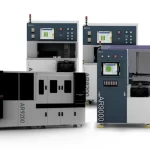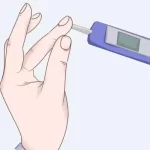Throughout the manufacturing industry, the chip manufacturing process is arguably one of the most complex. This art of turning stone into gold can be divided into eight major steps, as shown in the figure below, and these steps can be subdivided into hundreds of processes.
Manufacturing silicon wafers
The raw material used to make silicon wafers is sand, which is most commonly known as silicon dioxide. The sand is purified to obtain monolithic silicon, which is then pulled by direct drawing to obtain monocrystalline silicon ingots, which are first cut off at both ends and then cut into several sections and rolled to a standard diameter. Next, the X-ray method is used to determine the crystal orientation of the monocrystalline silicon, remove the reference surface, and then use the reference surface as a reference for cutting to obtain a silicon wafer, as shown in the figure below.
After getting the preliminary wafer, the cut silicon wafer is chamfered and ground to make its surface flat and smooth, otherwise it is difficult to engrave the correct circuit on it. After grinding, chemical etching solution is also used to remove the damage during grinding, and finally polishing solution is used to polish the wafer, and after passing the inspection, it can be handed over to the production line for manufacturing.
Thin Film Deposition
The second to sixth step is a process that needs to be repeated several times. Thin film deposition (deposition) is the deposition of thin films of materials onto the wafer surface. The deposited materials may be conductors, semiconductors and insulators, and the common films are silicon dioxide films, polysilicon films, silicon nitride films, metal and compound films, etc. The commonly used deposition methods are Chemical Vapor Deposition (CVD) and Physical Vapor Deposition (PVD), which is the process of introducing the vapor of the gaseous or liquid reactant that constitutes the thin film material into the reaction chamber at a reasonable flow rate, and the chemical reaction occurs on the substrate surface. The process method of depositing the film is shown in the figure below.
Physical vapor deposition is a process in which the material source (solid or liquid) is vaporized into gaseous atoms or molecules or partially ionized into ions and transferred to the silicon substrate surface to form a thin film under vacuum conditions, as shown in Figure 3-5. The disadvantage is that the step-coverage, adhesion and denseness are not as good as CVD films.
The common types of PVD include sputter coating, vacuum vapor deposition, and plasma coating. Take sputter coating as an example, it refers to the process of ionization of gas under a certain vacuum, in which the ions bombard the surface of the target, and the atoms and other particles on the surface of the target are transferred to the substrate in the gas phase, and a film is deposited on the surface of the substrate, as shown in the figure below.
Photolithography
Photolithography is the most central step in the entire manufacturing process. Before photolithography, photoresist is applied evenly on the wafer. Usually photoresist is applied by spin coating, i.e., rotating while smearing to ensure the uniformity of photoresist, as shown in the figure below.
After the photoresist is applied, the wafer is put into the photolithography machine, and the deep ultraviolet (DUV) or extreme ultraviolet (EUV) light emitted from the light source of the photolithography machine passes through the mask plate (also called photomask) to narrow and focus the circuit structure pattern on the mask plate to the photoresist layer, and after the photoresist is exposed to light, chemical changes will occur in the exposed area, and the circuit pattern on the mask plate will be printed on the photoresist layer, and this step is called exposure. as shown in the figure below. The step after exposure is baking and developing, the purpose of which is to remove the photoresist from the uncovered area of the graphic, thus allowing the printed circuit pattern to appear and be permanently fixed.
Etching
Etching (etch) is the process of chemically or physically selectively removing unwanted material from the silicon wafer surface after the photolithography step is complete, thus leaving only the 3D circuit pattern. The etching method mainly includes wet etching and dry etching. Wet etching is the use of chemical reaction between chemical solution and pre-etching material to remove the part not masked by the mask material to achieve etching purpose. Dry etching is a technique to etch the film with the nature of plasma chemical activity, and dry etching includes sputter etching (Supptter Etching), plasma etching (Plasma Etching), and reactive ion etching (Reactive Ion Etching, RIE). The etching process takes plasma etching as an example, using particles in the plasma to impact the silicon dioxide film layer to remove the excess oxide layer, as shown in the figure below.
Metrology and Inspection
After etching, the wafer is measured and inspected to ensure that there are no errors. If the results do not meet expectations, they should be fed back to the lithography or etching step for further optimization and adjustment. In fact, metrology and inspection can be done throughout the manufacturing process.
Ion Injection
Ion injection means that the atoms to be doped (e.g. group III and V elements) are accelerated into a specific region of the wafer under the action of a strong electric field, and then annealed, impurity activated, and lattice damage repaired to obtain the desired concentration of impurities, resulting in the formation of the N or P region.
Interconnection
Interconnection is the technology of connecting individual components within the same chip in a certain way to form a circuit module with certain functions. The metal material used for the interconnection process needs to have low resistivity, good thermochemical stability, good resistance to electromigration, easy deposition and etching, and low price. Early in the development of integrated circuits, aluminum interconnect processes were used, but copper was widely adopted because of its lower resistivity and better resistance to electromigration than aluminum.
These six steps, from thin film deposition to interconnect, are repeated dozens or even hundreds of times throughout the manufacturing process, and with each repetition, a layer of circuitry is etched on the wafer, eventually forming the complete chip. After all the above steps are completed, the wafer as a whole is sanded, polished, etc., then tested and packaged, and the qualified chip is ready for factory delivery!



